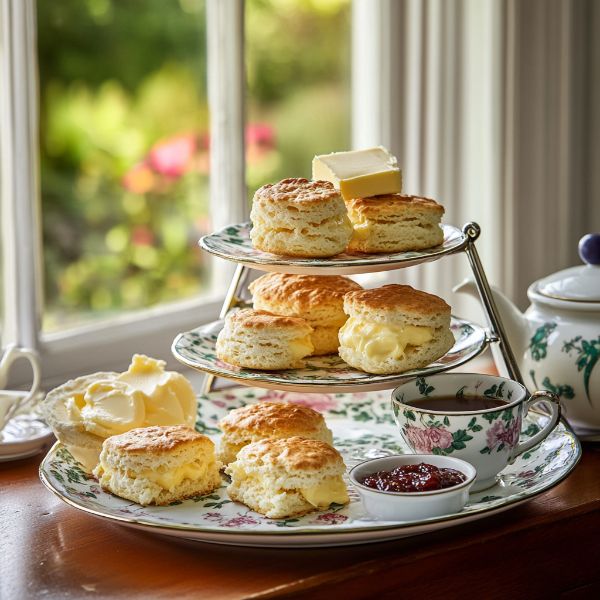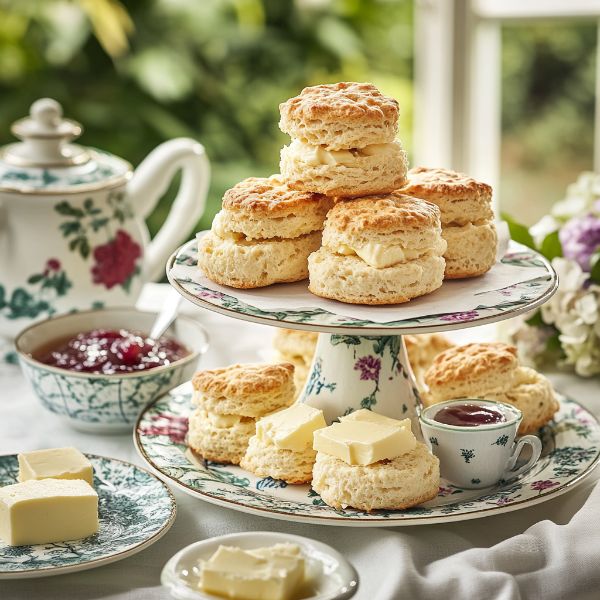The origin of the cheese scone traces back to the rich history of British baking, where it has evolved from a humble staple into a savoury twist on the classic scone. A cherished part of the UK’s culinary tradition, the cheese scone stands out for its unique flavour and versatility. This article explores the history, regional variations, and traditional techniques behind this beloved baked treat.
Introduction to the Cheese Scone
What is a Cheese Scone?
A cheese scone is a savoury baked good made from a simple dough enriched with cheese, typically served warm and enjoyed with butter or chutney. Unlike sweet scones often paired with jam and clotted cream, cheese scones are perfect as a snack, a side dish, or part of an afternoon tea spread. Their flaky texture and rich cheesy flavour make them a versatile favourite in British homes and cafés.
Overview of Scones as a Classic British Baked Good
Scones are a quintessential British delight, first emerging as a staple of rural kitchens in the 16th century. Originally made with oats and cooked on a griddle, scones have since transformed into a wide variety of baked goods. Today, they are most commonly associated with teatime and are enjoyed both in sweet and savoury forms.
Historical Background of Scones
Origins of Scones in British Culinary Tradition
The word “scone” is believed to have Scottish origins, potentially derived from the Gaelic word sgonn, meaning a shapeless mass or large mouthful. Historically, scones were simple, rustic fare made from accessible ingredients like oats, barley, or wheat. They were commonly cooked over an open flame on a griddle, offering a quick and satisfying bread alternative for rural communities.
Early Mentions of Scones in Literature and Cookbooks
The first literary mention of scones appeared in the early 16th century, but their formal documentation in cookbooks emerged in the 18th century. Mrs Beeton’s Book of Household Management (1861) provides early recipes, though these were plain and unembellished compared to modern interpretations.
Evolution from Plain Scones to Flavoured Varieties
As baking techniques advanced and regional ingredients became more accessible, the humble scone evolved. Sweet additions like currants and raisins became common, followed by savoury inclusions such as herbs and cheese. This marked a significant shift in the diversity of scone recipes, paving the way for today’s beloved cheese scone.
The Introduction of Cheese in Scones
When and How Cheese Became a Popular Ingredient in Scones
Cheese scones likely emerged during the late 19th century, as Victorian and Edwardian bakers experimented with savoury flavours to complement tea services. Cheese was a logical addition due to its strong, distinctive flavour and its role as a staple in British households. The popularity of cheese scones grew as they provided a satisfying alternative to sweet varieties, especially during occasions that called for more substantial fare.
Influence of Regional Preferences in the UK
The choice of cheese in scone recipes often reflects regional tastes. In the West Country, sharp Cheddar is the star, while Scotland favours crumbly, mild cheeses like Dunlop. These regional preferences have not only shaped the flavour profiles of cheese scones but also their texture and serving styles.
Regional Variations in Cheese Scones
How Cheese Scones Differ Across England, Scotland, and Wales
- England: Cheese scones are typically light and flaky, with sharp Cheddar or Red Leicester providing a robust flavour. Often served with chutneys or pickles, they are a staple of afternoon teas and café menus.
- Scotland: Scottish cheese scones are heartier and sometimes feature a crumbly texture. Local cheeses like Dunlop or Caboc lend a unique twist, often paired with butter.
- Wales: Welsh cheese scones embrace the country’s love for tangy Caerphilly cheese, sometimes incorporating leeks for added depth and a nod to traditional Welsh cuisine.
Role of Local Cheeses in Shaping Recipes
The use of local cheeses has been a defining characteristic of regional cheese scone recipes. For example:
- Cheddar (England): Bold and tangy, perfect for a classic cheese scone.
- Red Leicester (England): Adds a subtle sweetness and vibrant orange hue.
- Dunlop (Scotland): Crumbly and mild, ideal for a delicate scone.
- Caerphilly (Wales): Sharp and tangy, offering a distinctively Welsh flair.
Traditional Ingredients and Techniques
What Defines a Classic Cheese Scone Recipe?
A traditional cheese scone recipe includes:
- Plain flour: The base for a soft yet structured dough.
- Butter: Rubbed into the flour to create a flaky texture.
- Cheese: Finely grated for even distribution throughout the dough.
- Milk: Used to bind the ingredients and create a smooth consistency.
- Seasonings: Mustard powder or a pinch of cayenne for added depth.
Traditional Methods of Preparation and Baking
The method for preparing cheese scones involves:
- Mixing: Dry ingredients are combined before butter is rubbed in to form a breadcrumb-like consistency.
- Incorporating Cheese: Grated cheese is folded into the mixture.
- Adding Liquid: Milk is gently mixed in until the dough comes together without overworking.
- Shaping: The dough is rolled out and cut into rounds or wedges.
- Baking: Scones are baked in a hot oven (around 220°C) until golden and risen.
The traditional preparation ensures the signature lightness and rich flavour that make cheese scones so beloved.

The Cultural Significance and Evolution of Cheese Scones
Cheese scones hold a cherished place in British culinary tradition, bridging the gap between classic teatime fare and modern dining. From their origins in rural kitchens to their contemporary adaptations in global cuisine, cheese scones offer a rich narrative that reflects both tradition and innovation.
Cultural Significance of Cheese Scones
Cheese Scones in British Tea Culture
British tea culture is synonymous with indulgence and refinement, and cheese scones have carved a niche in this tradition.
- Afternoon Tea: While sweet scones with jam and cream dominate the scene, cheese scones are increasingly featured as a savoury complement. Paired with chutneys or butter, they offer a counterpoint to the sweetness of cakes and pastries.
- High Tea: Historically a more substantial meal, high tea often included savoury baked goods like cheese scones, served alongside cold meats, pickles, and hearty soups.
The inclusion of cheese scones in these settings highlights their versatility and enduring appeal in British dining culture.
Cheese Scones in Modern British Cuisine
Adaptations and Contemporary Recipes
Modern recipes for cheese scones have embraced new flavours and techniques while staying true to their roots. Some popular adaptations include:
- Additions: Incorporating herbs like chives or thyme, or spices like paprika and mustard, to enhance the flavour profile.
- Dietary Adaptations: Recipes featuring gluten-free flours or plant-based cheeses cater to diverse dietary needs without sacrificing taste.
These creative twists have helped cheese scones remain relevant in today’s kitchens and bakeries.
Use in Restaurants, Cafes, and Bakeries
Cheese scones are a staple in cafés and bakeries across the UK. Many establishments feature them as part of an all-day menu, serving them with:
- Soups, such as tomato or leek and potato, as a comforting pairing.
- Breakfast spreads, alongside eggs or smoked salmon.
High-end restaurants have also elevated cheese scones, using premium cheeses and artisanal ingredients to create gourmet versions.
Comparing Cheese Scones to Other Variants
Sweet vs Savoury Scones: How Cheese Scones Stand Out
While sweet scones dominate traditional afternoon tea, cheese scones bring a savoury balance that is both rich and satisfying.
- Flavour: Cheese scones rely on the sharpness of mature cheese, often enhanced with spices, offering a bold alternative to sugary counterparts.
- Occasions: Cheese scones are versatile, enjoyed at breakfast, lunch, or teatime, whereas sweet scones are largely reserved for dessert-like settings.
Pairings and Serving Suggestions for Cheese Scones
- Pair with herb butter, chutneys, or soft cheeses for a decadent snack.
- Serve alongside soups, salads, or roasted vegetables for a complete meal.
- Include in a cheese board for a creative, textural element.

The Influence of Scottish Cuisine
Scotland’s Role in Popularising Scones
Scotland’s influence on the scone tradition is undeniable. The term “scone” is believed to have originated in Scotland, and its early iterations were simple oat-based flatbreads cooked on griddles. Over time, these rustic staples evolved into the fluffy, baked treats we know today, with regional variations like cheese scones adding depth to the tradition.
Scottish Dairy’s Contribution to Scone Recipes
Scotland’s robust dairy industry has been instrumental in shaping scone recipes:
- Butter: High-quality Scottish butter adds richness to scone dough.
- Cheese: Traditional Scottish cheeses, like Dunlop or Isle of Mull Cheddar, lend unique flavour profiles to cheese scones.
This combination of heritage and exceptional ingredients has cemented Scotland’s role in the global appreciation of scones.
Cheese Scones Beyond the UK
Global Adaptations of Cheese Scones
British influence on global baking traditions has led to widespread adaptations of cheese scones. Examples include:
- Australia and New Zealand: Cheese scones are popular café fare, often paired with chutneys or bacon beef.
- South Africa: Scone recipes frequently include local cheeses and spices for regional flair.
- North America: Savoury scones are gaining traction, with cheddar and jalapeño versions offering bold flavours.
Influence of British Culture on Baking Traditions Worldwide
The export of British tea culture during the colonial era introduced scones to a global audience. Over time, local ingredients and techniques have enriched these recipes, creating a diverse range of savoury scones inspired by the original cheese scone.
Cheese scones exemplify the harmonious blend of tradition and innovation, making them a culinary icon both in the UK and abroad.
Modern Trends and the Timeless Appeal of Cheese Scones
The humble cheese scone has evolved far beyond its origins, embracing modern trends, new ingredients, and global recognition. As it adapts to contemporary tastes, the cheese scone continues to celebrate its roots in British culinary heritage while remaining a symbol of comfort and innovation.
Modern Trends in Cheese Scone Baking
Experimentation with Different Cheese Types
Cheese scone recipes have expanded to include a wide variety of cheeses, each lending a distinct flavour and texture. Modern trends include:
- Blue Cheese: The bold, tangy notes of blue cheeses like Stilton or Gorgonzola create a gourmet twist.
- Vegan Alternatives: As plant-based diets gain popularity, vegan cheeses made from nuts or soy are being used to replicate the creamy texture and flavour of traditional cheese scones.
- Artisanal Cheeses: Unique cheeses, such as Brie or Manchego, add an upscale touch to scones, appealing to adventurous foodies.
Incorporating Additional Ingredients
To keep cheese scones exciting and relevant, bakers are experimenting with new flavours and textures. Popular additions include:
- Herbs: Fresh rosemary, thyme, or chives bring aromatic complexity.
- Spices: Paprika, mustard powder, or chilli flakes add warmth and depth.
- Nuts and Seeds: Walnuts, sunflower seeds, or pumpkin seeds introduce a delightful crunch and added nutrition.
These creative twists demonstrate the versatility of cheese scones in catering to diverse palates.

Iconic British Cheeses in Scone Recipes
History and Popularity of Cheddar in Cheese Scones
Cheddar is the cornerstone of traditional cheese scones, prized for its robust flavour and melting qualities. Originating in Somerset, Cheddar has long been a staple in British cooking. Its sharp, tangy notes balance beautifully with the buttery richness of scones, making it a timeless favourite.
Using Artisanal and Local Cheeses for Unique Flavours
As the popularity of locally sourced and artisanal products grows, bakers are incorporating regional cheeses to elevate their recipes. Examples include:
- Red Leicester: Adds sweetness and a distinctive orange hue.
- Wensleydale: Offers a mild, crumbly texture perfect for delicate scones.
- Stilton: Brings boldness and a touch of luxury to modern recipes.
These cheeses celebrate the diversity of British dairy and showcase how local ingredients can redefine a classic.
Cheese Scones in Popular Culture
Mentions in British TV, Books, and Media
Cheese scones frequently appear in British media as symbols of homely comfort and tradition. For example:
- In TV shows like The Great British Bake Off, cheese scones are featured as technical challenges that test bakers’ precision and creativity.
- In literature, scones often serve as a metaphor for simplicity and warmth, evoking images of family kitchens and rural life.
These references reinforce the cheese scone’s role as a cultural icon.
Role in Showcasing British Cuisine Internationally
As ambassadors of British baking, cheese scones play a part in introducing British cuisine to a global audience. They are often included in British-themed menus at international cafés and featured in food festivals as an example of traditional yet adaptable British fare.
Cheese Scones and Home Baking Movements
Revival of Traditional Recipes During the Home Baking Surge
During periods of increased interest in home baking—such as the lockdowns of recent years—cheese scones have experienced a resurgence. Their simple ingredients and forgiving preparation make them an ideal choice for bakers of all skill levels. Many people turned to traditional recipes for comfort and nostalgia, rediscovering the joy of baking scones from scratch.
Influence of Online Baking Communities and Social Media
Platforms like Instagram, Pinterest, and YouTube have played a significant role in the renewed popularity of cheese scones. From sharing recipes to showcasing creative twists, online communities have made baking more accessible and appealing. Hashtags like #CheeseScones and viral trends featuring scone recipes have brought new life to this age-old treat.

Conclusion: Celebrating the Cheese Scone
Summary of Its Origins, Evolution, and Enduring Appeal
The cheese scone, born from humble beginnings in British kitchens, has evolved into a versatile and beloved baked good. From its origins in Scotland to its modern-day adaptations with gourmet cheeses and vegan alternatives, it continues to capture the imagination of bakers and food lovers alike.
Final Thoughts on Its Place in British Culinary Heritage
Cheese scones embody the best of British baking: simplicity, adaptability, and a deep connection to tradition. Whether enjoyed as part of a classic afternoon tea, as a snack with soup, or as a creative experiment in modern kitchens, cheese scones remain a testament to the enduring charm of Britain’s culinary legacy.
Cheese scones are more than just a savoury treat—they are a symbol of comfort, creativity, and cultural pride. Celebrate them in your kitchen, and be part of a tradition that continues to delight generations.
